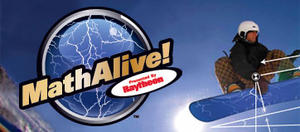EducationRaytheon launches MathAlive! to encourage math, science education
Results of a new survey of America’s middle school students show that nearly half of students aged 10-14 enjoy learning math outside of school and consider hands-on activities their favorite method for experiencing new subject material; Raytheon launches MathAlive! to encourage students to study math, science, and engineering

Raytheon launches MathAlive to foster math and science study // Source: raytheon.com
A team from the Organization for Economic Cooperation and Development, or O.E.C.D., has recently come out with a fascinating study mapping the correlation between performance on the Program for International Student Assessment, or PISA, exam — which every two years tests math, science, and reading comprehension skills of 15-year-olds in 65 countries — and the total earnings on natural resources as a percentage of G.D.P. for each participating country. In short, Tom Friedman writes, the PISA exam tests “how well do your high school kids do on math compared with how much oil you pump or how many diamonds you dig?” (see data map here).
Similar results have been reported by the International Mathematics and Science Study, or TIMSS.
Singapore, Finland, South Korea, Israel, Hong Kong, and Japan stand out as having high PISA scores and few natural resources. Canada, Australia, and Norway have both high score and natural resources.
Imagine what the United States, rich in natural resources, could do if it invested more in education, especially in math, science, and engineering education.
Raytheon, in addition to being one of the U.S. largest defense contractors, is also known for its commitment to promoting math and science education. The company has just launched its MathAlive!, an immersive exhibit enabling students, teachers, and visitors of all ages and backgrounds to experience what the company calls “the wondrous outcomes of science, technology, engineering and mathematics” (STEM) through highly engaging hands-on activities.
MathAlive! opened to the public on Saturday, 10 March, at the Smithsonian International Gallery.
Following a 3-month debut in Washington, D.C., MathAlive! will embark on a multiyear tour sponsored by Raytheon to science centers and museums in fifteen American and international cities, reaching an estimated four million visitors. Tour stops for 2012 include the Arizona Science Center in Phoenix, Arizona, and the U.S. Space & Rocket Center in Huntsville, Alabama.
The company says that MathAlive! is its latest response to the national imperative to improve students’ math proficiency. Leaders in business, government, and academia have expressed concern over the U.S. ability to produce tomorrow’s technical talent required to fuel innovation and assure American competitiveness.
“MathAlive! is designed to excite students by making real-world connections between math and the activities students already love to do,” said Raytheon chairman and CEO William H. Swanson. “Our goal is to engage and inspire today’s students to remain interested in math and science so that they have the opportunity to become the engineers and technology leaders of tomorrow.”
MathAlive! enables students and teachers to explore exciting STEM-powered activities such as designing video games, engineering cities of the future, and riding snowboards. Interactive stations allow students of various grade levels and capabilities to enjoy fresh subject matter to complement the math they experience at school and at home. The bilingual exhibit will be presented in English and Spanish in the United States, and in the native languages of host nations as well as in English when it travels internationally. Additional customization of the exhibit for international appearances will address aspects such as weights and measures, cultural factors and local education standards.
Raytheon says that Results of a new survey of America’s middle school students indicate that nearly half of students aged 10-14 enjoy learning math outside of school and consider hands-on activities their favorite method for experiencing new subject material. An infographic depicting key findings of the survey — plus photos, videos and personal stories relating to MathAlive! — is available on MathAlive!’s Tumblr page.
Raytheon notes that Institutional collaborators in MathAlive! include NASA, the National Council of Teachers of Mathematics, National Society of Professional Engineers, National Engineers Week Foundation, the Society of Women Engineers, and MATHCOUNTS.
MathAlive! is the largest-scale initiative to date of Raytheon’s MathMovesU, a national program inspiring students to embrace mathematics as a key to their future.
